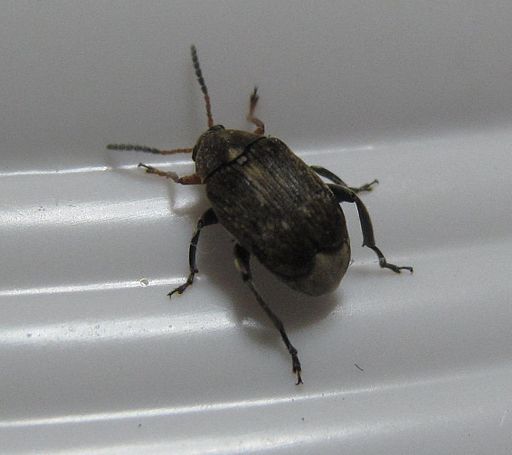SERVICE REQUEST?
Fill out the form below.
Find our nearest location
Your Local Office

Bean Weevil
Attribution: lillolollo, [CC-BY-SA-3.0], via Wikimedia Commons
Size:
1/6 of an inch
Color:
Olive brown with brown or gray spots on wing covers. Its thorax is covered with fine yellow-orange hairs.
Behavior:
The female bean weevil deposits her eggs on bean pods in the field or on whole beans in storage. Each female lays up to 60 eggs in her lifetime and numerous whitish eggs can be seen on a single bean. Bean weevils are internal feeders so the tiny, grub-like larvae bore their way into the bean. Several larvae may feed inside each bean and a considerable portion of the bean’s interior is consumed. It is the larvae that do the damage. Adults do not feed. Upon maturity, the larvae pupate near the surface of the bean and then emerge from the bean, leaving numerous holes in the bean. The entire life cycle can last from 21 days or as long as 80 days. Populations of bean weevils develop quickly in stored beans where suddenly hundreds or thousands of weevils are seen crawling or flying in infested rooms. The first indication of an infestation is often the presence of numerous flying weevils. A bag, box or storage bin of beans may be so infested that weevils are forced to leave the container in search of fresh beans on which to lay their eggs. Bean weevils “play dead” when disturbed and may take up to five minutes to resume movement.
Bean weevils infest only whole beans and other legumes and do not infest other types of stored foods such as cereals or whole grains.
The control of any stored product pest involves many steps, primary of which is discovery of infested food items or other sources of infestation (e.g., food spillage accumulation). When bean weevils are present, all items containing or made of whole beans need to be examined. Usually, bagged beans in the pantry are the source but some decorative items are made of or contain whole beans so such items should not be overlooked. Also consider the following to prevent an infestation: · Discard infested foods in outdoor trash. Infested decorations (flowers, wreaths, etc.) should also be discarded. · Freeze suspect foods at zero degrees Fahrenheit for six days. · Clean cabinets and shelves where infested foods are stored by vacuuming and by using soap and water. · Store all dried food goods, including dried pet foods and birdseed, in a glass or plastic container with a tight lid. If beetles are in that food product then the infestation will be contained and not spread to other foods.
Family Name:
Acanthoscelides obtectus
Read What Our Clients
Are Saying
My Terminix tech Scott is the best! He is professional, courteous and absolutely thorough about his job. Thank you for sending such a blessed tech to my house. Hamlet, NC
This letter is to say how pleased we are here at Morreene West Apartments with your services. We are very pleased with the technician, Christopher. He does a great job. Durham, NC
Terminix has consistently offered our apartment complex reliable, competent service. We are completely satisfied with their knowledgeable representative who is always punctual and does a superior job for us every time. Chapel Hill, NC
I would like to take the time to thank you for giving us such great service here at Carver Pond Apartments. Your Pest Technician Christopher Mitchell has provided us with excellent service over the last few months. Christopher is such a great help to us in providing helpful information so that we can better serve our residents here at Carver Pond. Durham, NC
SERVICE REQUEST?
Fill out the form below.